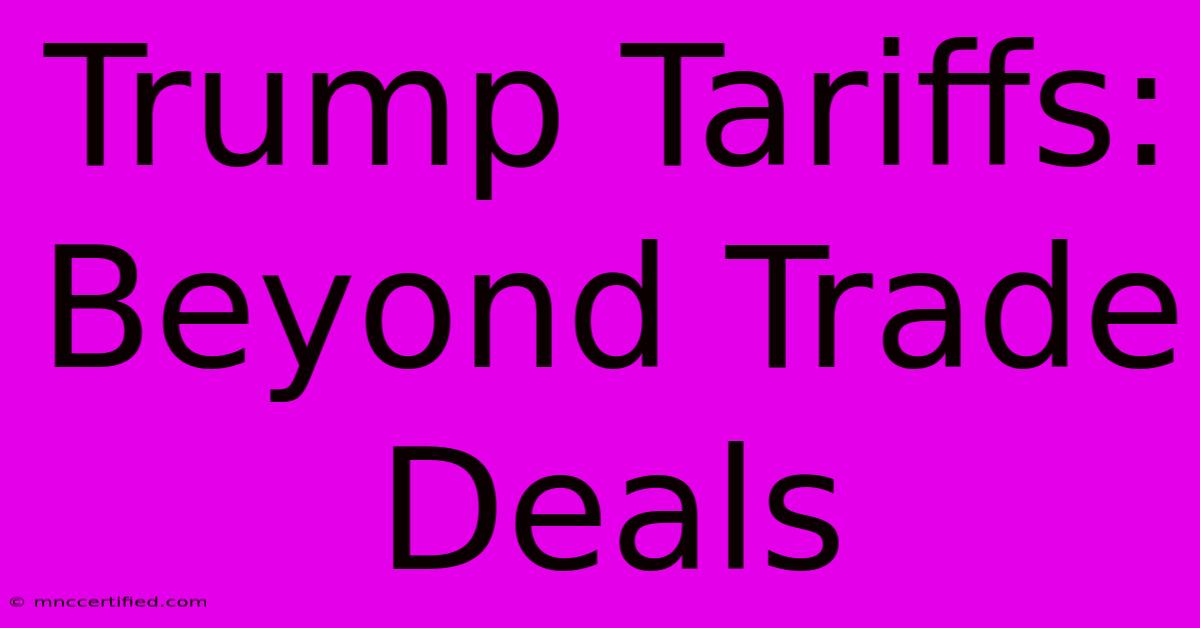Trump Tariffs: Beyond Trade Deals

Table of Contents
Trump Tariffs: Beyond Trade Deals – A Deep Dive into Economic Impacts
The Trump administration's imposition of tariffs on imported goods sent shockwaves through the global economy. While often framed as tools in trade negotiations, their impact extended far beyond simple trade deals, significantly affecting various sectors, industries, and consumers. This article delves into the complexities of the Trump tariffs, exploring their consequences and long-term implications.
Understanding the Rationale Behind the Tariffs
The stated goal of the Trump tariffs was to protect American industries from unfair foreign competition and rebalance the trade deficit. Specific targets included steel and aluminum from various countries, and a wide range of goods from China. The administration argued these tariffs would revitalize domestic manufacturing, create jobs, and bolster national security. However, the economic realities proved far more nuanced.
Key Arguments for the Tariffs:
- National Security: Tariffs on steel and aluminum were justified on the grounds of national security, arguing that reliance on foreign sources weakened the US's defense capabilities.
- Reciprocity: The administration aimed to pressure trading partners to negotiate more favorable trade deals by imposing tariffs as a bargaining chip.
- Protecting Domestic Industries: The tariffs were intended to shield American businesses from what were perceived as unfairly subsidized foreign competitors.
The Economic Realities: Winners and Losers
While the intended beneficiaries were American manufacturers, the actual effects were far more complex and often contradictory.
Winners (Limited and Contingent):
- Some domestic producers: Certain sectors, particularly in steel and aluminum, saw increased demand and profits in the short term due to reduced foreign competition. However, this often came at the cost of increased input prices for other businesses.
- Government Revenue: Tariff revenues increased significantly, providing a temporary boost to government coffers. However, this revenue is often dwarfed by the broader economic costs.
Losers (Widespread and Significant):
- Consumers: Higher prices on imported goods and goods produced using imported materials directly impacted consumers' purchasing power.
- Businesses reliant on imports: Businesses that relied heavily on imported materials faced increased production costs, forcing price increases or reduced profitability. This had a ripple effect across the economy, impacting various supply chains.
- Farmers: The retaliatory tariffs imposed by other countries significantly harmed American farmers, particularly soybean and pork producers.
- Global Trade: The tariffs disrupted global supply chains, reduced international trade volumes, and negatively impacted global economic growth.
Beyond Trade Deals: The Broader Impacts
The consequences of the Trump tariffs extend far beyond the immediate realm of trade negotiations.
Inflationary Pressures:
The tariffs contributed to inflationary pressures, as increased input costs were passed on to consumers in the form of higher prices. This exacerbated existing inflationary concerns and affected the overall cost of living.
Geopolitical Tensions:
The tariffs fueled trade wars and increased geopolitical tensions with major trading partners like China and the European Union. This created uncertainty in global markets and hindered international cooperation.
Long-Term Economic Effects:
The long-term economic consequences are still unfolding. While some argue that the tariffs spurred domestic investment and job creation, the evidence suggests that these benefits were limited and outweighed by the negative impacts on consumer welfare, business investment, and global trade.
Conclusion: A Complex Legacy
The Trump tariffs represent a complex and controversial chapter in modern economic history. While intended to protect American industries and improve trade balances, their actual impact was far more intricate and often detrimental. Analyzing their consequences requires a comprehensive understanding of their ripple effects across various sectors and the broader geopolitical landscape. The long-term effects continue to be debated and analyzed, highlighting the need for cautious consideration before implementing similar trade policies in the future. Understanding the intricacies of such policies is crucial for businesses, policymakers, and the general public alike.

Thank you for visiting our website wich cover about Trump Tariffs: Beyond Trade Deals. We hope the information provided has been useful to you. Feel free to contact us if you have any questions or need further assistance. See you next time and dont miss to bookmark.
Featured Posts
-
Feyenoord Comeback Man Citys 3 Goal Lead Gone
Nov 27, 2024
-
Bayern Psg Champions League Live Score Updates
Nov 27, 2024
-
Chiropractor No Insurance Cost
Nov 27, 2024
-
Uk Diplomat Expelled Russias Accusation
Nov 27, 2024
-
Myers Stevens Toohey Insurance
Nov 27, 2024